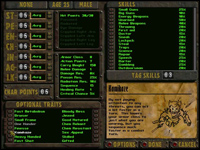Devil’s Advocate: Depth vs Trial & Error
 When it comes to classic cRPGs, there’s one thing that is usually true: they give you a lot of freedom. Along with that usually comes depth: the liberty to play the game the way you want to which is what makes them so popular. Do you want a single wizard or two? Two fighters or just one and a ranger? Will you let the ranger double as a healer? Or maybe as a rogue? There isn’t one single way of playing them and there’s a lot of different guides and character builds to be found online. And yet, many gamers forget that this has its downsides …
When it comes to classic cRPGs, there’s one thing that is usually true: they give you a lot of freedom. Along with that usually comes depth: the liberty to play the game the way you want to which is what makes them so popular. Do you want a single wizard or two? Two fighters or just one and a ranger? Will you let the ranger double as a healer? Or maybe as a rogue? There isn’t one single way of playing them and there’s a lot of different guides and character builds to be found online. And yet, many gamers forget that this has its downsides …

You see, many of the cRPGs are incredibly hard for newcomers. They have to learn the real meanings behind the stats (how does ‘perception’ affect how I actually play) and also learn which stats prove to be more vital than others. The manual may very well claim that dexterity lets you avoid damage but to what extend? Is a dexterity of 14 a lot worse than 18? Are there ways to compensate? Or does a good suit of armour provide an alternative? The advice will often be: experiment, replay and mess around. But this is what this Devil’s Advocateis about: too many of the classics are very hard to get into due to non-transparent game mechanics.
Evidence of this, are the many guides that can be found on the Internet which help you create “ideal” builds. You may say “but that doesn’t mean you need an ideal build to complete the game!” and indeed, that’s true. But the very knowledge that is needed to create these builds, is also the knowledge that is needed to complete the game without ideal builds if you get what I mean. A lot of cRPGs are nail hard even on the easiest of settings and to compensate for a poorly made team, you need to know the game through and through – meaning a newcomer is screwed both ways. As a result, I always suggest people consult a character guide, letting them at least have an ideal party to play with so they can get to grips with the game without getting stomped into the ground every 10 minutes.
On top of this, a lot of games have stats that look better on paper than in practice. Fallout 1 & 2 have almost identical game mechanics yet in Fallout 2, some stats are more vital than in Fallout 1 because of the type of enemies you’ll encounter, the type of quests you’ll need to do and the kind of gear that can be collected. How can you know this before having played both games? You can’t. Not in a million years. That’s where trial & error comes in: you learn and adjust to what you need the most in a game. It’s not fair by a long shot and while the many choices given add a lot of depth, it also adds many opportunities to screw up massively or at the very least, have a less-than-ideal character in games that are already notorious for being tough.
Don’t get me wrong, without all those options, they wouldn’t be as great as they are, but it would certainly have been a lot more fun if the developers had added an option to reallocate skills and attribute points inside the game so we could undo mistakes or adjust without having to restart completely or dig out a savegame editor (I usually use the latter when possible).
Bottomline: if you want to enjoy classic cRPGs and have never played them before, expect to sweat a lot – either over guides & manuals, or in the game.
Posted on January 10, 2012, in Game Rants and tagged Baldur's Gate, cRPG, devil's advocate, Fallout, guides. Bookmark the permalink. Leave a comment.

Leave a comment
Comments 0